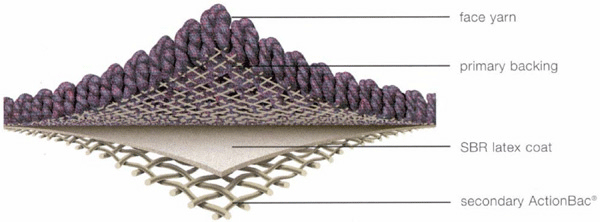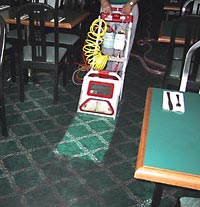Carpet Care Tip of the Month
Printed From: Carpet Cleaning Forum
Category: Carpet Cleaners Discussion
Forum Name: Carpet Cleaning Tips and HOW-TO-SECTION
Forum Description: Periodically KK gives you a new tip. Add one of your own if you wish
URL: https://www.kleenkuip.com/forum/forum_posts.asp?TID=774
Printed Date: 28/December/2025 at 2:02am
Software Version: Web Wiz Forums 12.06 - https://www.webwizforums.com
Topic: Carpet Care Tip of the Month
Posted By: carpetologist
Subject: Carpet Care Tip of the Month
Date Posted: 17/November/2004 at 2:56pm
|
Why Carpet Should be Cleaned Three-Dimensionally As I travel the country speaking at seminars on facilities carpet care, I am struck by a fundamental misconception that facilities cleaning personnel have about carpet: It is perceived to be a one-dimensional floor covering.
It is no wonder that we have so many problems with carpet maintenance. We attempt to clean carpet without fully understanding the characteristics of the textile we're cleaning. Consequently, we utilize tools and cleaning techniques that are ill suited to the task at hand. We use tools rotary-style floor machines with pads or brushes, self-contained extractors that spray, brush and extract all in a single step that are adaptations of tools used to clean one-dimensional hard-surface floors. But as noted above, carpet isn't one-dimensional. Carpet cleaning efforts that mimic hard-surface floor cleaning, using tools and techniques that only clean the surface of the carpet, fail because two dimensions of the carpet have not been cleaned. Clean All Dimensions
So how do we clean carpet three-dimensionally? Following is a three-step system that will achieve the objective. Three-Dimensional Cleaning Step 1: Soil Suspension To begin, apply a traffic lane prespray to loosen the bound soils on the carpet surface. Wide variations in prespray performance (in terms of cleaning effectiveness and soil-attracting residues) has made clear that the use of a top-quality traffic lane prespray will pay dividends in the form of better results and labor savings. Next, use mechanical action (agitation) to break loose the bound soils. Counter-rotating cylindrical brush machines are the preferred tools for this. They not only provide superior agitation, the brushing action pulls particle soils up to the surface where they can be more easily extracted. Finally, allow your prespray 10-15 minutes of dwell time to maximize soil suspension. Step 2: Soil Extraction When using a high-flow system for the extraction step, it is recommended that in the traffic areas you overlap your cleaning passes by half in order to maximize soil removal. The view window on the extractor allows the operator to see how much additional soil is being removed the second time over an area. Step 3: Drying In the facilities world, one-dimensional carpet care has been ingrained for so long that the concepts described in this article may be difficult to accept at first. But consider this: We've been cleaning carpet in facilities one-dimensionally for years and facilities carpet care has been a problem for years. In fact, many facilities cleaners would just as soon get rid of all the carpet and replace it with tile, because they are able to maintain tile successfully. (Of course, the cost to maintain tile is about double that of carpet.) If you are challenged by unacceptable carpet cleaning results, try something different. Try the techniques described in this article. You'll be amazed at the difference. And if you aren't, call me on the carpet. Article courtesy of cmmonline.com and John Downey Company ------------- Kleen Kuip Supply Mart Inc. http://www.kleenkuip.com - New & Used Professional Carpet Cleaning Machines, Restoration Equipment, Training, Service and Supplies |
Replies:
Posted By: sidvermawt
Date Posted: 21/September/2011 at 5:44am
| Nice tips buddy i love them. I hope it will be prove very useful for everyone thanks alot... |
Posted By: postroadcarpetoneofa
Date Posted: 22/September/2011 at 4:48am
| Really Nice tips shared here. It will help us a lot and also break some superstitions about carpet cleaning. |
Posted By: CarpetCleanersUSA
Date Posted: 28/September/2011 at 6:02pm
|
Came across your tips. Really great one and worth reading! Thanks for sharing.
|
Posted By: joncamerun
Date Posted: 20/October/2011 at 11:54pm
| Thanks for the resource. The tips you provided are very helpful. |
Posted By: acecleancarpets
Date Posted: 27/November/2012 at 2:31pm
| Great tip and breakdown of an explanation! |
Posted By: westcovina
Date Posted: 19/February/2013 at 10:15pm
|
Great information and nice read. ------------- http://www.example.com - http://www.carpet-cleaning-pasadena-ca.com/ |
Posted By: ValenciaJohn
Date Posted: 18/March/2013 at 1:50am
Hey thanks for this tips ,its really valuable for newbie and expert too.....I will go through with these tips and suggest my clients to follow this tips.Thanks!!!!
|
Posted By: fhiggins
Date Posted: 09/January/2014 at 12:22pm
| That was a good read. I learned alot from the info. |
Posted By: NicholsoncleaninG
Date Posted: 27/May/2021 at 3:45am
| Thank you for the tips! Going to be useful for me! |
Posted By: ChristopherShanon
Date Posted: 18/August/2021 at 3:03am
|
I am
thinking about to purchase carpet thatβs why I was searching suggestions on the
internet. You write your post about cleaning which will be beneficial to me.
Thanks for sharing this article. |
Posted By: Connie T. Causey
Date Posted: 21/September/2021 at 5:32am
| Thanks you so much for sharing these tips. |

 Once soils have been suspended, they must be removed. In order to do this effectively, a high-performance hot-water extraction system should be used. The options are truckmounts, portable truckmounts and high-flow extractors. Field studies have shown that high-flow extraction systems deliver superior extraction results. This is because high-flow systems remove substantially more soil by using four to six times as much of the media (water) that carries the soil out of the carpet, while leaving the carpet as dry or dryer than self-contained extractors. To better understand how this concept works, consider how vacuums remove dry soil. In vacuuming, air is the media that carries the soil from the carpet. Increased airflow results in increased soil removal. Likewise with water extraction cleaning, increased water flow results in increased soil removal.
Once soils have been suspended, they must be removed. In order to do this effectively, a high-performance hot-water extraction system should be used. The options are truckmounts, portable truckmounts and high-flow extractors. Field studies have shown that high-flow extraction systems deliver superior extraction results. This is because high-flow systems remove substantially more soil by using four to six times as much of the media (water) that carries the soil out of the carpet, while leaving the carpet as dry or dryer than self-contained extractors. To better understand how this concept works, consider how vacuums remove dry soil. In vacuuming, air is the media that carries the soil from the carpet. Increased airflow results in increased soil removal. Likewise with water extraction cleaning, increased water flow results in increased soil removal.